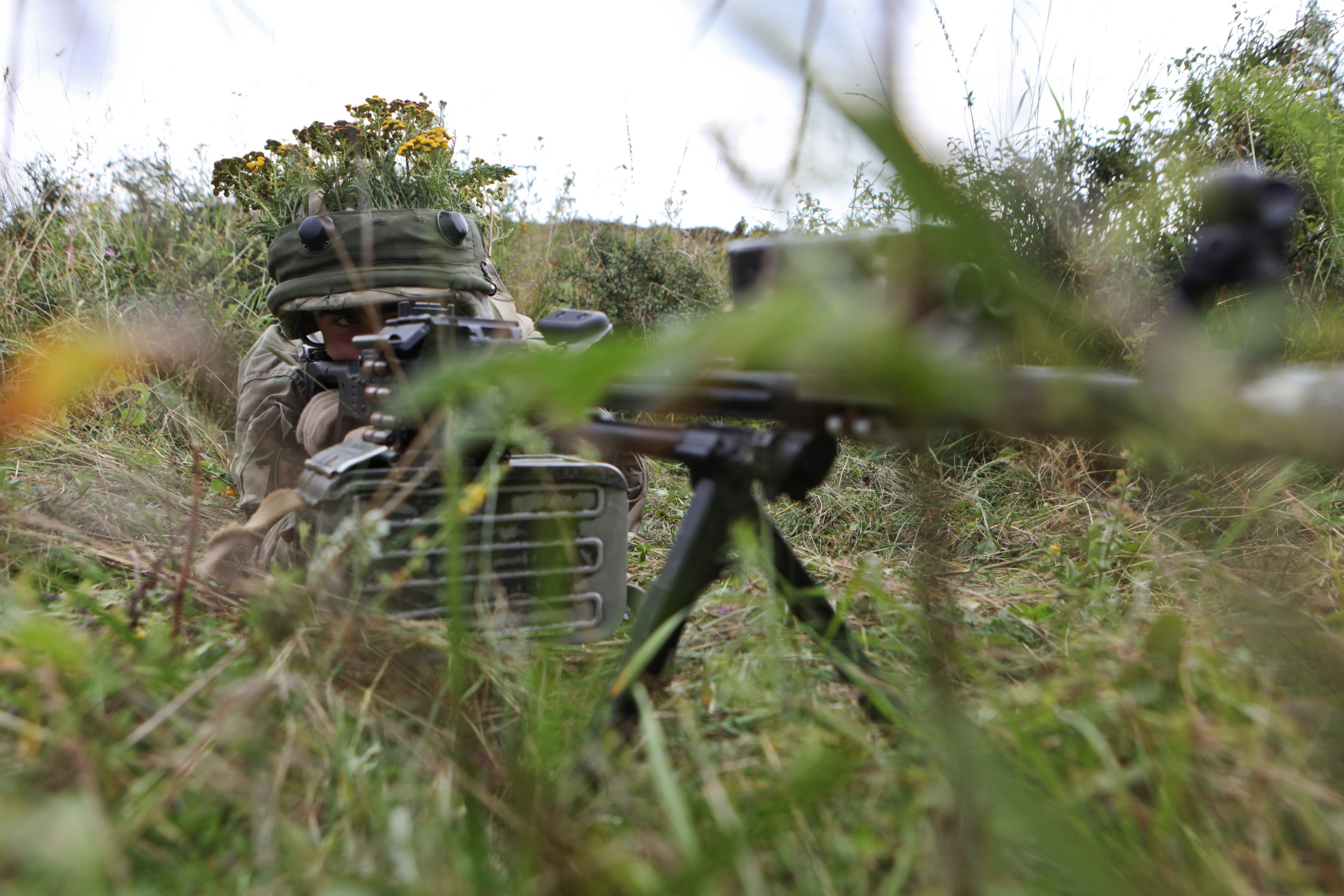A nation must think before it acts.
The breathtakingly fast Taliban takeover of Afghanistan raised serious questions about U.S. efforts to build military capacity there and in other places. After 20 years of effort costing some $825 billion in direct military expenditures alone,[1] and the loss of over 3,500 American and coalition lives, the U.S.-built Afghan security forces collapsed within weeks. What made their collapse even more stunning is that they were routed by Taliban fighters armed mostly with light weapons, while the Afghan military had advanced heavy weapons at its disposal. Some in the U.S. have sought to pin the blame solely on the Afghan security forces, claiming that they lacked the will to fight. This is an unfair accusation: Some 66,000 Afghan security forces were killed[2] in the fight against the Taliban and its allies. Those are not the casualty figures of an army afraid to fight.
The collapse of the Afghan military was not due to cowardice among Afghan soldiers, but to incapacity at higher levels of Afghan defense institutions. Some of the blame for this incapacity clearly falls on Afghans themselves. Corruption, nepotism, and pursuit of self-interest at the expense of the national interest pervaded Afghan security forces and did much to undermine U.S. capacity-building efforts. But the U.S. must take some of the blame, as well. Although it is important to understand what happened in Afghanistan, isolating the causes of the U.S. failure to build resilient security forces there is an almost impossible task: The number of variables at work and the scale of the effort defy simple analysis.
But similar, smaller U.S. efforts to build capacity in key partner nations may more readily yield insights, since the scale of the effort is more modest and the number of factors influencing the outcome should be fewer. Here, Georgia may provide a good example. To be clear, Georgia is not Afghanistan. Georgia is a modernizing, westernizing state with near universal literacy and an educational system on par with some in Europe. Its nearly two decade-long effort to root out corruption has paid dividends: Georgia ranks as the 45th least corrupt country in the world, while Afghanistan sits near the very bottom at number 165 out of 179.[3] Their level of economic development also differs greatly: Afghanistan’s per capita GDP is only 12% of Georgia’s.[4] In short, Georgia is in most ways a less challenging environment for U.S. military capacity-building efforts.
But some of the same incapacity at higher levels of the defense enterprise that doomed the U.S. effort in Afghanistan also exists in Georgia. Understanding why this is, and how the U.S. can address the shortcomings in its approach, is the focus of the rest of this article. This article does not engage the broader question of whether the U.S. should engage in defense capacity-building abroad. Instead, given a decision to build capacity in partner nations, it asks how the U.S. can do this most successfully. This article also does not engage the issue of social, political, or economic conditions and their impact on defense capacity-building. While it is likely that these play a role in the success or failure of capacity-building efforts, addressing them is beyond the scope of an article of this length.
The Problem
After more than 19 years of significant U.S. military assistance, starting with the Georgia Train and Equip Program (GTEP) in 2002, Georgian Defense Forces (GDF) units still suffer from severe readiness problems. Over almost two decades of intensive effort, with the expenditure of hundreds of millions of dollars and the deployment of thousands of U.S. military trainers to Georgia, the average Georgian infantry battalion has been trained between three and five times and deployed several times to Iraq or Afghanistan. But visits to these same battalions by U.S. advisors months after they have been trained show serious erosion of the capabilities built with U.S. help. Problems like missing or inoperable equipment, poorly trained personnel, personnel shortages, and lack of logistical support are endemic.[5]
This is not to say the U.S. has not benefited from its investment in the GDF. Since 2004, some 30,000 Georgian soldiers have deployed to Iraq or Afghanistan. In Afghanistan, Georgia was the #1 per capita contributor of forces and the #4 overall contributor until the end of the mission this year. In both Iraq and Afghanistan, Georgian forces operated largely free of national caveats and did the hard fighting that many NATO Allies avoided. Overall, 35 Georgian soldiers were killed and over 310 were wounded fighting alongside American forces in these two conflicts.[6]
As impressive as these contributions are, they do little to sustain Georgia’s ability to defend itself, as the problems detailed above make clear. They also do little to support larger U.S. national security policy objectives. Since at least 2008, across four presidential administrations, U.S. policy has held that Georgia deserves admission to NATO. While that question is largely political at this point, the serious issues in the GDF give ammunition to those allies who claim Georgia is militarily unprepared for NATO membership and would be a liability to the Alliance. The dominant model of assistance in Georgia also does little to achieve the Office of Defense Cooperation objective that “Georgia possesses an institutional planning and training capacity that yields a credible, sustainable, organic deterrent capability, and is also able to maintain contributions to coalition operations.”[7] Were the traditional model able to deliver this objective, it would have done so after 19 years of sustained effort.
The Causes
The fault for this lies with no single individual or institution — Georgian or American. Instead, the cause of the problem lies in three factors that are present in Georgia, but also characterize many U.S. military assistance programs around the world. The first factor is that for too long U.S. assistance to Georgia was focused on training and equipping Georgian units to deploy to counter-insurgency operations in support of the U.S. and NATO, and not on developing a capacity for Georgia to defend itself. In fact, in some cases U.S. policy specifically precluded helping Georgia defend itself. As an example, when I was the Chief of the Office of Defense Cooperation from 2006-2008, I was told not to assist with the development of courses for artillery officers because Georgian artillery was not needed in Iraq and because the move would be seen as “provocative” to Russia.
Although combat deployments are widely seen as helping units become more proficient, the skills Georgian units developed in Iraq and Afghanistan are different from those needed to fight an invader at home. In their deployments, Georgian units were fighting insurgents; in defending their homeland against an aggressor with vastly superior military power, they will need to be insurgents themselves. In Iraq and Afghanistan, Georgian units deployed under U.S. command were moved to and from theater by the U.S., and sustained by the U.S. in-theater. Therefore, Georgia never developed the capacity to command, control, move and sustain its units in a combat environment, all of which are critical to its ability to defend itself.
The Georgian Defense Readiness Program (GDRP), which began in 2018, improved the situation by focusing explicitly on developing Georgia’s capacity to defend its own territory. While this marks progress, it doesn’t change the fact that the vast majority of U.S. effort since 2002 contributed little to this goal. In a country not being considered for NATO membership, this might not be a problem, since the U.S. might have no commitment to defending the partner nation. But in Georgia, neglecting territorial defense for 16 years served to undermine the U.S.’ own policy objective of helping Georgia enter NATO.
The second factor is that U.S. efforts focused for too long on the tactical level, largely neglecting the levels of the Georgian defense enterprise that sustain tactical level units. In U.S. Army doctrinal terms, the units that do the fighting are the operating force; the organizations that generate and sustain the operating force comprise the generating force. Above both are the organizations that manage the entire defense enterprise, which are on the executive level. The problem with a focus on the operating force is that the units that do the fighting can’t generate and sustain themselves. Absent a significant investment in the generating force, it is inevitable that the readiness of Georgian units will erode after the completion of a U.S. assistance program. This is because the generating force performs the functions critical to sustaining the readiness of the operating force. These include recruiting, organizing, supplying, equipping, training, educating, constructing, and maintaining operating force personnel, equipment, or facilities.[8] In short, while capability resides in the operating force, capacity resides in the generating force. U.S. Department of Defense Joint Publication 3-01 says, “Capability refers to the [partner nation’s] ability to execute a given task while capacity refers to the [partner nation’s] ability to self-sustain and self-replicate a given capability.” For too long the U.S. engaged in capability-building in Georgia, while often calling it capacity-building.
Until recently, what little U.S. effort there was at the generating force and executive levels was divorced from efforts at the operating force level, and was mostly conducted by contractors from for-profit firms, instead of military and civilian U.S. Department of Defense employees. While the contractors themselves were generally well-qualified and well-meaning, the incentive structure of a contractor-focused model does not lend itself to building locally owned, sustainable capability in the partner nation. Instead, the incentive for the contractor is to become indispensable to the partner nation, leading to preservation and hopefully expansion of the contract. In Georgia, this often resulted in the contractor doing things for the Georgian MOD and Defense Forces, rather than helping their Georgian counterparts learn to do it themselves. To give but two examples: Until recently, 10 of the 18 courses at the Georgian Command and Staff College were taught by U.S. contractors; and key strategies in the Ministry of Defense were often written first in English by U.S. contractors, and only then translated into Georgian. Before the U.S. Office of Defense Cooperation decided to significantly downsize the U.S. contractor presence in Georgia, their contract was consuming $10 million of an annual Foreign Military Financing (FMF) budget that averaged $30-35 million in recent years.[9]
A corollary to the problem of contractor-led assistance is the problem of “supply-side assistance.” This occurs when organizations involved in institutional capacity-building (ICB) in the U.S. “market” their services to partner nations, rather than assistance being contingent upon a demand signal from the partner nation, validated by the Security Cooperation Organization (SCO) in the U.S. Embassy. Most partner nations, unwilling to appear ungrateful, will gladly accept whatever assistance is offered, even if it doesn’t address an important national interest and even if the partner nation lacks the ability to absorb and sustain it. While such “marketing” allows ICB-providers to claim relevance and secure funding, for the SCO, it represents a drain on its finite resources without the payoff of achieving important U.S. or partner nation interests.
The third factor is the following pattern, which exists in Georgia but also in many other places where the U.S. undertakes capacity-building efforts:
- The U.S. and the partner nation sign an agreement that ties U.S. assistance to progress in reforms that will enable the partner nation to independently sustain capability built with U.S. help.
- Senior U.S. leaders in Washington, D.C., press the U.S. Embassy Country Team to ensure the partner nation meets the requirements in the agreement; Country Team members stress to their counterparts the seriousness with which the U.S. takes the agreement.
- The partner nation fails to meet some of the requirements in the agreement and the U.S. Embassy Country Team recommends modification or suspension of some U.S. assistance until those conditions are met.
- Senior U.S. leaders reject this recommendation, citing the importance of the partner nation’s commitments to coalition operations, its strategic location, or other factors.
There are three major problems with this pattern, which has repeated itself time and again in U.S. military assistance efforts. First, it paints the Country Team as unreasonable and out of touch with what its own senior leadership values, undermining its ability to do its job. Second, it fails to create incentives for the partner nation to undertake the reforms that are often painful but critical to its ability to defend itself. Third, it ensures a portion of U.S. assistance is wasted, since capability built with U.S. help is allowed to erode due to the partner nation’s failure to implement the reforms required to sustain it. Until U.S. political and military leaders are willing to enforce the conditions they place on U.S. assistance, that assistance will fail to produce the effects the U.S. and the partner nation desire.[10]
The Solution
Building capacity in Georgia — and elsewhere — does not require a fundamental retooling of U.S. assistance. The changes required are simple and achievable. First, as it has with GDRP, future U.S. assistance should focus on building a country’s capacity to defend itself rather than its capacity to deploy in support of U.S. and coalition operations. In Georgia’s case, as long as its eventual NATO membership remains a U.S. policy goal, assisting in the development of its capacity to defend itself improves its chances of receiving an invitation to join the Alliance and ensures that it doesn’t become an unacceptable liability once it does. If certain capabilities are required in support of U.S. or coalition operations, the U.S. can help Georgia develop them, but the weight of effort should remain on building capacity for territorial defense.
Second, rather than focusing on the operating force, U.S. assistance should focus on the generating force and executive levels, which are critical to building and sustaining capacity. The generating force needs to produce the doctrine, training, education, personnel and equipment required to sustain the operating force without external assistance. The executive level needs to produce the policies, strategies, and plans required to resource and employ the operating force. U.S. assistance at these levels should avoid using contractors from for-profit firms whenever possible. The misalignment of incentives between for-profit contractors and the U.S. government is simply too great to make contractors a staple of efforts to build capability that partner-nations can independently sustain. Instead, what is likely to happen is that the contractor will opt to do things for the partner nation — teach classes, and write strategies and plans, for example — rather than teach the partner nation to do these things for itself.
Finally, the U.S. needs to carefully consider and consistently enforce any requirements written into the agreements that underpin U.S. capacity-building efforts. Simply put, the U.S. should determine the conditions required for the partner nation to independently sustain capability built with American assistance, and if the conditions in the agreement aren’t met, we should modify or pause assistance until they are. We should develop these conditions jointly with the partner nation as we plan a capacity-building effort to ensure the conditions are achievable and have buy-in from both sides. If the conditions aren’t met, it will result in some uncomfortable conversations for senior U.S. leaders, but will ultimately ensure that the U.S. doesn’t waste money and effort, and that the partner nation reaps the maximum benefit from U.S. assistance.
While this article has focused on Georgia, its lessons are applicable to many countries where U.S. capacity-building programs are underway. By investing in territorial defense (especially where the country’s security is a U.S. policy goal), by investing in the generating force and executive levels while minimizing the role of for-profit contracting firms, and by enforcing common-sense conditions on U.S. assistance, the U.S. can ensure that its investment in building defense capacity in key partner nations is as effective as possible.
The views expressed in this article are those of the author alone and do not necessarily reflect the position of the Foreign Policy Research Institute, a non-partisan organization that seeks to publish well-argued, policy-oriented articles on American foreign policy and national security priorities.
[1] “Afghanistan: What has the conflict cost the US and its allies?” BBC, internet resource at: https://www.bbc.co.uk/news/world-47391821, last accessed October 19, 2021.
[2] Ellen Knickmeyer, “Costs of the Afghanistan war, in lives and dollars”, AP, August 17, 2021, internet resource at: https://apnews.com/article/middle-east-business-afghanistan-43d8f53b35e80ec18c130cd683e1a38f, last accessed October 19, 2021.
[3] “Corruption Perceptions Index 2020”, Transparency International, internet resources at: https://www.transparency.org/en/cpi/2020/index/geo, last accessed October 19, 2021.
[4] Afghanistan’s 2020 per capita GDP was $549, while Georgia’s was $4679. Figures from Trading Economics, internet resource at: https://tradingeconomics.com/afghanistan/gdp-per-capita and https://tradingeconomics.com/georgia/gdp-per-capita, last accessed October 19, 2021.
[5] Home Station Visit Reports by U.S. trainers and advisors, January-July 2021.
[6] Office of Defense Cooperation Georgia, “ODC Bilateral Security Relationship”, April 2021
[7] Ibid.
[8] U.S. Army Field Manual 1-01: Generating Force Support for Operations, April 2008, p. 1-02.
[9] Interviews with U.S. officials in Georgia, January-July 2021.
[10] This point does not apply to legally mandated conditionality, such as human rights vetting, often called “Leahy Vetting” after the sponsor of the law that mandates it. Instead, this point is directed at the reforms a partner nation must take to allow it to independently sustain capability built with U.S. assistance. U.S. leaders regularly ignore these well-intended and necessary conditions when the partner nation fails to meet them.



